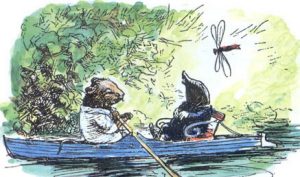
The children’s novel The Wind in the Willows from 1908 by Kenneth Grahame does not seem like a very obvious work of culture that investigates posthuman conditions. Nevertheless ideas of unity and otherness are certainly present in the book. The animals, like Mole, Rat and Badger, all behave like humans and together they live in a very British community in the countryside, but they are also very different from each other; not only by moods and faculties, but by the fact that they are all different species. Because of this they have different positions in their society. Unity comes when they face the Wide World, a place of mystery and danger beyond their little community. The ultimate other for these animals is the human race(!) and our technology, like the car that disrupts the rural idyll. In many ways the novel is about change and threatening modernity, but it also shows how unity disappears when the great other is not considered. Amongst themselves the animals are in fact divided in many social classes based on races.
Leave a Reply
3 Comments on "The Wind of Change"
Thank you Kristian for bringing a smile on my face this morning – the characters in The wind ind the Willows as well as the characters in Beatrix Potter’s Peter Rabbit were my first encounters with a non-human animal perspective on the world – that is, a human non-human perspective. Have a good day in the Wide World!